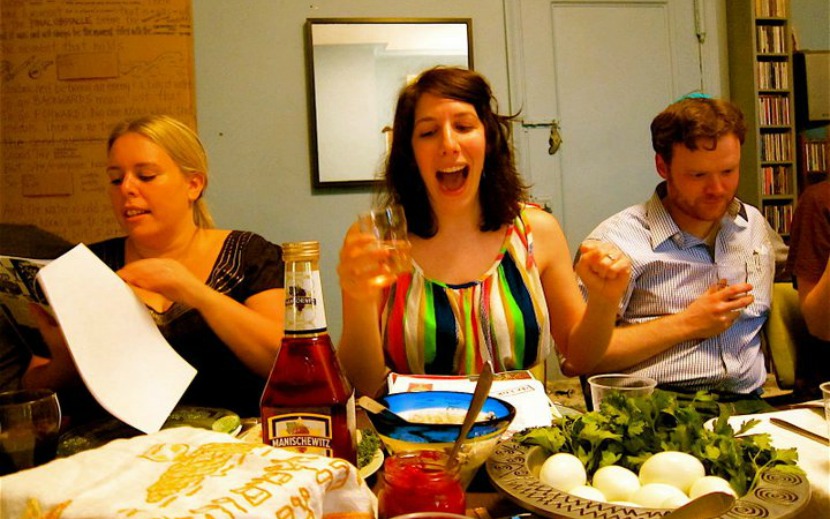How to Host a Seder

Every culture and religion has its way of honoring change and growth and process, of marking time and of recognizing hardship and overcoming obstacles. The Jewish holiday of Passover is all of that mashed into one weeklong holiday, highlighted by an epic festival meal called seder, which involve lots of unleavened bread and snorting your way through a pile of fresh horseradish and gefilte fish. Mash-Up HQ has never met a festival meal we didn’t like, so we asked our Jewish-American Mash-Up Franny Silverman for her rules on making this year’s seder our very best.
What is a seder? Seder is dinner theater, experiential education, drunken family karaoke game night, debate team and group therapy mashed into one meal. The word literally means order, but from my many years as a professional Jew, I can tell you that following the rulebook does not a good seder make. Except for mine! So go forth with these eight rules, ask hard questions, reflect, celebrate, and, of course, eat.

1. Eat these foods!
On all other days, we might eat our feelings. But on Passover, we are invited to eat our story. Every family has their own must-have dishes, and there are a number of symbolic foods and drinks, which can be served on a special plate for foods of meaning. Highlights include:
Matzah for the bread that was baked but didn’t have time to rise because ye olde enslaved Hebrews had to GTFO.
Horseradish to bring us to bitter tears like those who are oppressed.
Tear-like salt water to dip symbolic springtime greens into (in case the horseradish didn’t bring you to tears).
Haroset, my all-time fave tradish symbolic food (besides all four glasses of wine). It’s a sweet, chutney-like spread made from chopped fruits and nuts with exact recipes varying by region. Usually brownish-red, haroset represents mortar of the supposed bricks of slavery, but more importantly, it’s a great complement to the horseradish. This particular mash-up was made popular by a famous old rabbi named Hillel, who slapped the bitter and the sweet together between two pieces of matzah and called it a sandwich.
In recent decades, progressives have added these other symbolic foods to the seder table: Olives, Orange, Banana, Chocolate,Tomato, Glass of Water and even an overtly inedible Lock and Key. Each of these represents a different contemporary issue drawn in comparison or relation to the Exodus tale.
2. Tell your story, and that of others.
Seder is basically an elaborate storytelling exercise in building empathy. The OG Baby Moses story goes like this: Moses was the rescued son of an oppressed people, the Jews, who became the leader of their liberation from slavery. It’s a hero’s journey that you can use for source material at your seder, where you can share current and personal stories of oppression and liberation — #BlackLivesMatter, Anti-Human-Trafficking, Environmental Justice are just a few examples. If improvising isn’t your thing, you can create your own haggadot, or seder guidebook, to tell a liberation story, here.
You can also take Bob Marley as your guide: “Emancipate yourself from mental slavery…”
3. Ask questions.
It’s all about questions. There are four beloved traditional questions called the Mah Nishtanah, which begin with: Why is this night different from all other nights?
I challenge you to really ask that question at your table. What is different this Passover from last? What has changed? What has stayed the same? How is it all sitting with you?
And when your guests ask you what they can bring to the seder, invite them each to bring one question for the group.
4. Invite strangers.
“I say to Him, ‘God is it okay to luff strangers?’ And God says to me, ‘Yitzak, vat is dis strangers? You make strangers. I don’t make strangers.’”
Kitchen Table Wisdom by Rabbi Naomi Remen
Over and again, ancient Jewish texts talk about how the Hebrews were once strangers and therefore have a responsibility to welcome, feed, clothe, and love the strangers among them. So invite a stranger to your seder! This can mean inviting someone you don’t know very well, or perhaps someone who is not a stranger to you personally, but to the seder tradition. The more the merrier, so make sure to have your guests bring a plus one, too.
5. Be free!
If the goal is for everyone to experience the liberation, then that includes you! Liberate yourself from feeling responsible for everything. Freedom is a messy business. Embrace it, alongside your guests.
6. Give thanks.
The classic seder tune, “Dayenu,” means “it would have been enough.” Not in a kvetchy or sarcastic way, but as a sincere expression of gratitude. There are many, many verses in Hebrew proclaiming how it would have been enough just to be liberated from slavery, to receive the Torah, to be gifted the Sabbath, etc.
But whether you sing some, all or none of the traditional verses, I recommend opening “Dayenu” up as a full group activity, where everyone offers their own “dayenu” for the year.
It would have been enough if (enter something positive here), but also (enter some bonus positivity here) ! Dayenu! Day-day-enu…etc…
For example:
“It would have been enough if my toddler only knew the words to “Tomorrow”, but she actually can belt out an adorable rendition of “You’re Never Fully Dressed Without a Smile” as well. Dayenu!”
Pro-tip: The more wine, the better the dayenus.
7. Sing!
I mean it! A traditional seder ends with a big communal singalong. But a singalong is no fun if you’re at a table of ten and only 1.5 people know the Passover-y songs in Hebrew. So instead, ask several people to bring a popular song that has a Passover-y theme. Or, here are some of my recommended jams: Free to be You and Me, Sing, Go Down Moses, She’ll be Comin’ Round the Mountain. Basically, anything James Taylor, Nina Simone, John Denver, Tracey Chapman, Bob Marley or Joni Mitchell will serve you well.
8. Hope.
One of the last moments of the seder is the declaration “Next Year in Jerusalem.” Sure, this can be taken as a literal wish, but the longing for Jerusalem is an ancient one, and I see it as an opportunity to set intention for the future. What is your Jerusalem?
So this year, if the folks at your table are comfortable writing on the holiday (people who practice strict adherence to Jewish law may not be), pass around some paper, envelopes, and writing tools, and invite your seder-mates to write a brief note to their future selves inspired by “next year in Jerusalem,” metaphorically. Everyone seals and addresses their envelope to themselves, and you take responsibility for keeping the notes all year and mailing them the following Passover season.
Happy Pesach, Mash-Ups. For more holiday inspo, check out these stories:
Passover Tales: Sometimes You Forget and Eat Bread
From High Church to High Holidays
Want more? Sure you do! Sign up for weekly Mash-Up delights.



![[Image Description: Photo of a Mexican American woman smiling at the camera. She has layered brown hair that rests below her shoulders and wears a sleeveless navy blue shirt, and silver earrings. Behind her are colorful framed photographs and artwork.] Photo Credit: Columbia Spectator, Michael Cao](https://www.mashupamericans.com/wp-content/uploads/2021/02/MariaHinojosa_030521_EDITED_1d-248x194.jpg)

